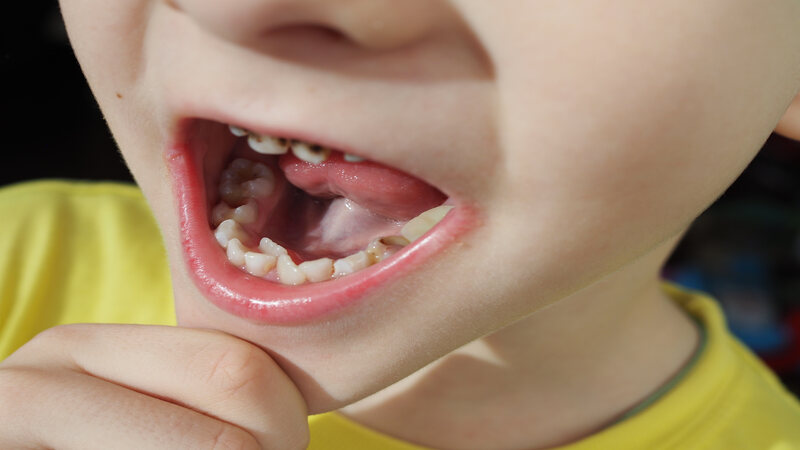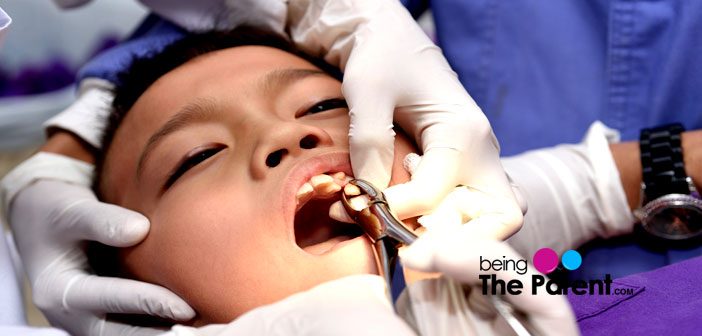
Your baby’s first toothy grin will always remain in your mind. Nevertheless, what happens if your child has sprouted one (or more than one) extra tooth than usual? The extra teeth can develop anywhere within the oral cavity (need not be precisely on the gum line). This is a rare condition affecting 1% to 4% of the children. This condition of supernumerary teeth is called Hyperdontia.
What Is Hyperdontia?
What Causes Hyperdontia In Children?
How And Where Do The Extra Teeth Sprout?
Should The Extra Teeth Be Removed?
What Are The Side Effects Of Hyperdontia?
The Treatments Available For Hyperdontia In Children
What Is Hyperdontia?
Usually, a child gets all his deciduous teeth (milk teeth) before the third birthday. There will be 20 numbers of milk teeth. Around 5 to 6 years, they start to shed milk teeth. By the time they reach twelve, 28 permanent teeth will replace their milk teeth (wisdom teeth, four in number, will come later between 17 to 21 years). At any of these stages, if the child possesses more than the average number of teeth, he is said to have Hyperdontia. Also, once your child has extra milk teeth, his chances of having extra permanent teeth are even higher.
What Causes Hyperdontia In Children?
Even after years of studies done in this field, no conclusive reason has been found to pin down Hyperdontia, though, there are a few hypotheses.
- A few specialists pin the cause behind this phenomena on the environmental factors (though, exactly which element in nature triggers this condition is still unknown)
- Some of them believe that genetic factors play a role behind this, as the children born to parents with supernumerary teeth are found to inherit additional teeth
- However, others believe it is connected with some disorders, as the extra teeth growth is often related to youngsters suffering from:
-
- Cleidocranial Dysostosis: This is a hereditary disorder involving the growth of bones and teeth. The clavicle bone will totally or partially absent in a child who has this genetic disorder. Children born with this type of disease tend to have supernumerary teeth.
- Ehlers-Danlos syndrome: This is a rare hereditary disease resulting in a group of connective tissue disorder, one of which causes problems with teeth formation of supernumerary teeth
- Down’s syndrome: Abnormal teeth formation and supernumerary teeth are common among the children with Down’s syndrome, commonly found chromosomal genetic disorder
- Cleft lip or cleft palate: Additional conical-shaped small teeth are usually found among children born with cleft lip or cleft palate Most likely, additional teeth are located on either side of cleft lip or cleft palate
How And Where Do The Extra Teeth Sprout?
The new tooth can grow in two ways. Firstly, it may develop from an extra tooth bud in the tissue, or else, a permanent tooth bud divides into two parts, resulting in the development of two teeth (one from each section), rather than one. It gets to be obvious around the time youngsters start to lose their milk teeth.
These new teeth can be located anywhere inside the mouth-not merely in the gum line. These supernumerary teeth can show up behind or before the permanent teeth, or along the top of the mouth. It can be unilateral or bilateral, single or multiple, erupted or unerrupted.
Here are some interesting facts for the supernumerary teeth:
- It is found that boys are more inclined to this than the girls
- More often supernumerary teeth appear between the permanent teeth rather than milk teeth
- Sometimes the additional teeth will not emerge from the gum and therefore lay undiscovered until an x-ray of the gum is taken for some causes
- The supernumerary teeth if not extracted on time can sometimes fuse with the permanent teeth
- An 11-year-old girl in the UK happens to have 81 teeth!

Should The Extra Teeth Be Removed?
Even though in some cases, the extra tooth possesses no discomfort or issues for the child, quite often the child can experience several problems like:
- Displacement of regular teeth: The extra tooth that grows will displace the regular adjacent teeth from their original position. These displacements vary from mild to complete rotation of the original teeth, messing up with its alignment
- Blocks the normal tooth eruption: Failure or delayed eruption of the permanent teeth is a significant consequence of Hyperdontia in children
If your children are experiencing the above issues, then the extra teeth should be removed.
What Are The Side Effects Of Hyperdontia?
- Crowding of teeth: Your child’s gum line and mouth are designed to hold the same number of teeth that generally occur. Therefore, the additional teeth will bring about congestion of the teeth. This can distort and dislodge the teeth. Thus, the child will even have trouble in chewing and biting the food properly
- Cyst or tumor formation: There are increased chances of cyst and tumor formation among the children with Hyperdontia
- Issues with speech: The clarity of the speech of the child can be severely affected due to the abnormally increased number of teeth in the oral cavity. Additional teeth can unfavorably affect your child’s learning capacities, as he will not have any desire to talk since he sounds abnormal or experiences issues with articulating words
- Increases the chances of tooth decay and cavity: Irregularly shaped and sized teeth increase the chances of tooth decay, as there will be more chances of food particle being stuck between teeth. Besides, proper brushing will be painful with all those extra teeth
- Irregular facial appearance: The teeth have a un-negligible role in defining the facial appearance of the child. Too many teeth in the mouth can adversely affect the facial appearance, which in turn may affect the child’s confidence level
What Are The Treatments Available For Hyperdontia In Children?
Usually the parents take the child to the doctor only if the issues bother the normal life of the child. However, never wait until that. Consult a qualified and well-experienced pediatric dentist once you notice an abnormal growth pattern of teeth in your child. Once the doctor finds out that the issue is due to supernumerary teeth, then you have to remember and understand the following facts:
- Extraction of extra teeth: Extracting the extra teeth is an effective way to treat this one. Local anesthesia is applied during this procedure so that the child experiences no pain during the extraction
- Wait and watch approach: The tooth extraction relies on the area where the additional tooth is situated and its connection to the adjacent teeth. If the doctor does not anticipate any issues from the extra tooth, by means of orthodontic tooth movement, he will monitor the development of the teeth. This is done by taking x-ray annually. The doctor chooses to follow a wait and watch attitude
- Endodontic treatment: The doctor will depend on this method (which is similar to root canal treatment) only if the extra grown tooth fuses with the permanent teeth. Here, the tissue around the root of the melded tooth is removed (only after waiting until the root completes its cycle of development). After that, the fused tooth is surgically removed. This is because as the roots of tooth joins together. Hence, the best means to remove the fused tooth is through surgery
- Orthodontic approach: The extra teeth will probably affect the alignment of the teeth. Therefore, after extraction (if needed) orthodontic measures like dental braces are used to restore the alignment and to strengthen the teeth
It is more beneficial to set off your child’s association with a dental practitioner by the age of one. Monitoring the child’s mouth from the early stage of tooth development will help to detect the issues as soon as they emerge. Medical science is progressing. This makes the treatment for conditions like additional teeth fruitful without any side effects. If treated by the right doctor at the right time, supernumerary teeth are not a problem.

